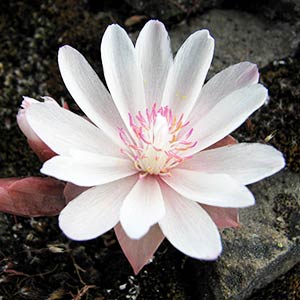Lewisia rediviva
Lewisia nevadensis
bitter root, bitterroot lewisia, resurrection flower
Nevada bitterroot, Nevada lewisia, Sierra lewisia
gradually ramified distally.
napiform to shortly fusiform.
procumbent to erect, 1–3 cm.
suberect, becoming horizontal or deflexed after anthesis, base subterranean, 5–12 cm.
basal leaves withering at or soon after anthesis, sessile, blade linear to clavate, subterete or grooved adaxially, 0.5–5 cm, margins entire, apex obtuse to subacute;
cauline leaves absent.
basal leaves withering at or soon after anthesis, gradually narrowed to broad petiole, blade narrowly linear to linear-oblanceolate, flattened, 4–15 cm, margins entire, apex obtuse to subacute;
cauline leaves absent.
with flowers borne singly;
bracts 4–7(–8), whorled, subulate to linear-lanceolate, 4–10 mm, margins entire, apex acuminate.
usually with flowers borne singly, rarely 2–3-flowered in racemose cymes;
bracts 2, opposite, linear-lanceolate, 6–18 mm, margins entire, apex acute.
pedicellate, disarticulate in fruit;
sepals (4–)6–9, broadly elliptic to ovate, 10–25 mm, scarious after anthesis, margins entire to somewhat erose, apex obtuse to rounded;
petals 10–19, usually rose to pink, sometimes lavender, sometimes with paler or white centers, or wholly white, elliptic, oblong, or narrowly oblanceolate, 15–35 mm;
stamens 20–50;
stigmas 4–9;
pedicel (1–)3–15(–30) mm.
pedicellate, not disarticulate in fruit, 0.5–2 cm diam.;
sepals 2, broadly ovate, 5–13 mm, herbaceous at anthesis, margins entire or with few shallow, nonglandular teeth, apex acute to subacute;
petals 5–10, white or rarely pinkish, elliptic to oblanceolate, 10–15(–20) mm;
stamens 6–15;
stigmas 3–6;
pedicel 10–40 mm.
5–6 mm.
5–10 mm.
6–25, 2–2.5 mm, shiny, minutely papillate.
20–50, 1.3 mm, shiny, muricate.
= 26, 28.
= 56.
Lewisia rediviva
Lewisia nevadensis
Varieties 2 (2 in the flora).
Native Americans commonly ate the boiled roots of Lewisia rediviva.
(Discussion copyrighted by Flora of North America; reprinted with permission.)
Lewisia nevadensis represents one extreme of the L. pygmaea complex (see discussion under 13. L. pygmaea). Questionable geographic occurrences reflect plants that have one or more features otherwise suggestive of L. pygmaea (e.g., more elongate roots, truncate and/or toothed sepals, and colored petals); such intermediates also occur in the range of “typical” L. nevadensis (relatively robust plants with napiform roots, solitary flowers, acute sepals with entire margins, and white petals). Uncertainty respecting the affinity of specimens prevails in those from Arizona, Colorado, Idaho, and Wyoming. There are no supporting specimens from Wyoming.
B. L. Davidson (2000) noted that Lewisia nevadensis is a garden weed in Colorado; it is not clear whether or not these plants are escapes from cultivation.
The floral symmetry of Lewisia nevadensis may be somewhat elliptical, the two outer sepals and the remaining petals imbricate and opposite the sepals, giving the flowers a pinched appearance, a feature also reported for L. oppositifolia.
(Discussion copyrighted by Flora of North America; reprinted with permission.)
1. Basal leaf blades clavate to narrowly oblanceolate, grooved adaxially; sepals 10-12(-15) mm; petals 15mm; stamens 20-30 | var. minor |
1. Basal leaf blades linear, subterete, not grooved adaxially; sepals 15-25 mm; petals 18-35 mm; stamens 30-50 | var. rediviva |
- Local floras:
BC,
CA,
OR,
WA
- Local Web sites:
CalFlora,
CalPhotos,
Flora NW,
PNW Herbaria,
Turner Photog.
WildflowerSearch
iNaturalist (observations)
USDA Plants Database
- LBJ Wildflower Center
- SEINet
- Plants of the World Online
- Encyclopedia of Life
- Wikipedia
- Google Image Search


